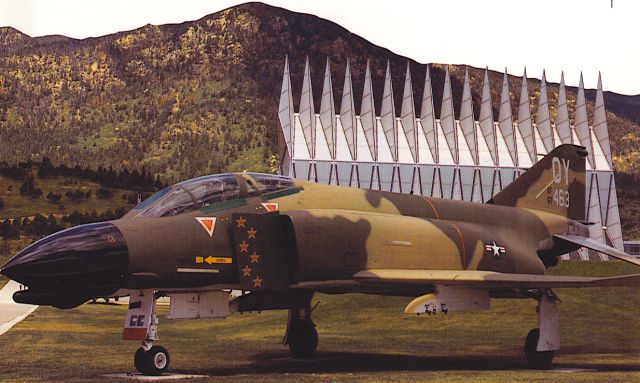
Ace F-4D Final Mission
By TSgt. Allen L. Eakle, NCOIC, Academy Media Relations Division, Checkpoints Magazine, Spring ’87
In November 1986, after nearly two decades of service, a McDonnell Douglas Corporation F-4D Phantom II with a unique war history began its last journey to a permanent home at the Air Force Academy.
This Phantom II is the aircraft in which then-Captain Steve Ritchie, who graduated from the Academy in 1964, became the first Air Force ace of the Vietnam War.
Before the war ended, the plane would be credited with six MiG kills, the only aircraft credited with six kills since the Korean War. Two of Ritchie’s five kills were in this F-4D. Academy Classmate Fred Olmsted, also used this plane to record a MiG kill on March 16, 1972.
The aircraft, which was previously assigned to the 31st Tactical Fighter Wing at Homestead AFB, FL, was flown to Peterson AFB, CO, by Colonel H. Hale Burr, Jr., 31st TFW Commander, and Lt. Col. Herbert H. Johnson, 307th Tactical Fighter Squadron Commander. They were escorted by a pair of F-16 Fighting Falcons, also from Homestead.
“It’s my pleasure, sir, to give you ‘463,’” said Burr to Lieutenant General Winfield W. Scott, Jr., Academy Superintendent, who accepted the plane on behalf of the Air Force Academy. The number is part of the aircraft’s tail number, 66-463. “She s been a good aircraft and Code 1 (mission ready).”
Also there to greet the Phantom on its last flight was someone who knew it well, then-Colonel Steve Ritchie (USAFR).
“Why don’t you get in and try it out?” said Burr to Ritchie. “I bet it’ll feel good—like an old shoe.”
Ritchie climbed into the front cockpit for probably the last time, looked around and worked the controls, and then gave a thumbs up to the delight of the media and spectators who were here for the plane’s arrival at Peterson.
“There’s definitely an emotional attachment,” said Ritchie. “Each airplane has a spirit and life all of its own. This is a very special airplane.”
Two of the six red stars painted on the engine inlet ramps—signifying MiG kills—belong to Ritchie. He shot down the first (and the plane’s fourth) MiG on 10 May 1972.
“It was a bittersweet day.” said Ritchie. ‘‘One of my classmates, Bob Lodge, was shot down that day. He was on his third tour and already had three kills. He was about to make his fourth when a MiG got him.”
After shooting down his fourth MiG, Ritchie selected “463” to fly from then on. “It had good radar and fewer write-ups than any other aircraft,” he remarked. His name was painted on the side of the aircraft and he flew it daily for several months.
On 28 August 1972, Ritchie bagged his fifth (and the airplane’s fifth) kill to become the first American ace to shoot down five MiG-21 Fishbeds. He flew his Phantom to Saigon the following day for a press conference. It was the last time he flew it.
Two months later the plane was credited with its sixth kill. It remained in Southeast Asia until 1975 and in the Pacific for another five years until assigned to Homestead in 1980.
A team from the Ogden Air Logistics Center, Hill AFB, Utah, prepared the F-4D for static display at the Academy. The engines, all avionic and electronic components, and all usable parts that could be taken out without marring the outer display were removed.
“They’re taking most of her guts out—the engines and radars,” said Ritchie. “I just hope the spirit remains with the airplane.”
The Phantom was repainted to look as it did in Southeast Asia, complete with six bright red stars, and transported to the Academy. A formal dedication ceremony welcomed the Academy’s newest addition as it began its final mission.
“I’m glad she’s going to the Academy,” Ritchie said. “She represents what the Academy is all about. I hope the spirit of the plane will be an inspiration to the cadets.”

[ My History ] [ Home ] [ Table Of Contents ]